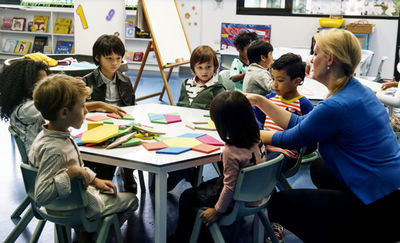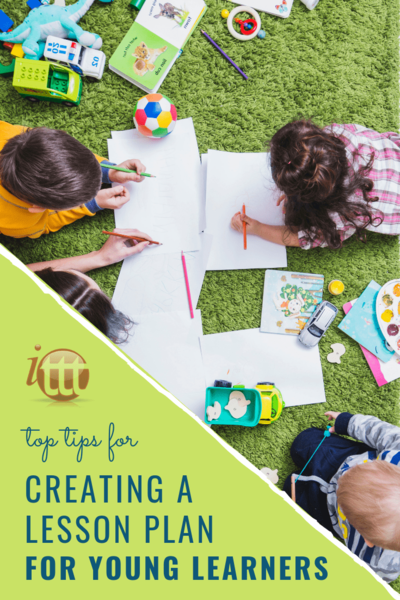Top Tips For Creating An EFL Lesson Plan For Young Learners

With each passing day, we learn something new. We build upon the previously attained knowledge and expand our understanding of various subjects. As teachers, we have the responsibility of expanding our students' knowledge and abilities. As much as we would like to provide fun and innovative ways to present the information, it can be difficult to keep it fresh on a daily basis.
Table of Contents
WHAT DOES A LESSON PLAN CONSIST OF?
Now you're ready! Remember, be creative and make it your own.
There are many factors to take into consideration when teaching a new subject: what, when, how, where, and why. Because we have many factors to consider, it's vital to be as organized as possible. The tool we use to achieve this, is a lesson plan. In today's blog, we will briefly discuss what a lesson plan is, the 5 elements mentioned above, and go into depth about what a lesson plan may consist of.
Take ITTT's 50-hour Teaching English to Young Learners course and get a head start!
WHAT IS A LESSON PLAN?
A lesson plan is a tool an educator uses to organize and structure the methodology they are going to use during a specific lesson or class.
Even though we don't specifically state the 5 elements of a lesson, they must be considered when planning out a lesson. To successfully elaborate an efficient lesson plan, we must know what each element means and how they come into play.
WHAT
The "what", entails determining what is going to be taught during a lesson. This includes vocabulary, sentence structures, pronunciation, etc.
WHEN
The "when", is deciding the best time to employ your desired activity or the time limit per activity. An example is deciding the best time to play a game and for how long.
HOW
The "how" is determining the best strategy for achieving our goals during a class. This can also include the materials or resources you may need.
WHERE
The "where", is deciding which place is most suitable for teaching a certain subject. A few examples can be a fieldtrip, playground, beach, park, classroom, etc.
WHY
The "why", is the act of reviewing our lesson plan and checking to see if everything in the lesson has relevance for the subject that is going to be taught during that day.
By asking ourselves these 5 questions, we can create an efficient lesson plan that covers most, if not all, the students' needs. This tool also provides a reference point for us to analyze, what's working, and what's not working. In a moment, we will see what components make up a lesson plan.

WHAT DOES A LESSON PLAN CONSIST OF?
Each lesson plan is unique and can be made into anything you want it to be. Here, we are going to layout a generalized concept of a lesson directed towards a younger audience.
Take ITTT's 50-hour Teaching English to Young Learners course and get a head start!
WARM-UP
A warm-up is any activity that allows the students to energize and focus on the class that they are about to have. It's important to set up a warm-up activity because it creates a preface of what they can expect from the class and invites a welcoming atmosphere. The warm-ups should be fun, high energy, and short in nature. Here are a few ideas:
- Dance
- Simon Says
- Sing a song
- Hot Potato and answer questions
REVIEW
This stage gives us an idea of how well the students retained the information from the previous class. It's important to just do a quick analysis and not focus too much on every mistake or missing piece of knowledge. Just as the warm-up, the review should be short as well. Here are some examples on how to do review in a quick easy way:
- Hangman (Perfect for vocabulary.)
- Hopscotch (Draw or make an obstacle course on the floor and have the student go through the obstacle course and retrieve the corresponding flashcard.)
- Musical Chairs (The eliminated students answer a question or identifies a vocabulary word.)
NEW SUBJECT
This is where we present the new information to our students. When presenting new information, we should take a hierarchical approach. What do I mean by this? Let's say your topic for the day is furniture. First, we should show an image of a house, and have students determine what that picture is. Then, show the main rooms of a house. Lastly, show some furniture. Since furniture is the main topic, we should place our main focus on furniture and not the other subjects.
It sounds contradictory, but there is a methodology behind it. We do this in order for the students to correlate new information with previously attained knowledge and spark a conversation. This allows them to think in English, and not just translate the vocabulary from their native tongue. This is where we must make use of our time wisely.
Now that the new information has been introduced, it's time to see how much of the information the students have retained.

GAME
This section is where a teacher's creativity can run loose. Any game can be modified to achieve the goal. Here are some cool game ideas for this part of the class:
- Duck, Duck, Goose (Have the person running answer a question.)
- Hide and Seek (With flashcards.)
- Block Race 1 vs 1 (Build a tower you specify and run to the correct flashcard.)
WORKSHEET
This stage, means we're reaching the conclusion of the class. Worksheets are tools that cement the understanding of the new information. It provides the students with a resource to review and take home. These worksheets should be age appropriate, while at the same time, provide a form of entertainment for the children. Some examples are:
- Connect the dots.
- Word Search.
- Match the word with vocabulary and color.
- Writing Practice.
- The possibilities are endless.
FINAL TIPS
As you can see, this form of lesson planning is game orientated. The reason is that we are dealing with children. Since they lack the attention span of adults, it's important to have a lesson plan that grasps the students' attention/interest. At every stage, we should apply an activity that is fun and exciting.
Another thing to be wary of, is our use of time. This lesson plan is meant to be malleable and be used according to your needs. Feel free to adjust, repeat, or even add stages. Since class times vary from school to school, adapt this to your available schedule.
Lastly, it's vital that students have an opportunity to speak at every stage. The student's exposure to the language is most likely limited to the time inside the classroom. So, we should provide the students with plenty of time to speak and practice. The speaking allotted time can be, but not limited to: questions and answers, listening and repeating, or reading out loud.
Now you're ready! Remember, be creative and make it your own.
Apply now & get certified to teach english abroad!
Speak with an ITTT advisor today to put together your personal plan for teaching English abroad!
Send us an email or call us toll-free at 1-800-490-0531 to speak with an ITTT advisor today.
Related Articles:
- The How-To Guide to Prepare for Your Teaching Job Abroad
- Two Traveling Teachers Share What It's Like Teaching English Abroad as a Couple
- Guide to Writing a TEFL Resume That Will Get You Hired
- Top 10 Places to Take Your TEFL Course in Spring
- 8 Important Tips For Good Classroom Management
- 6 Steps To Becoming a More Confident Teacher




